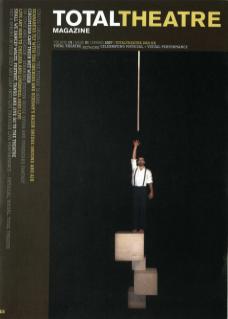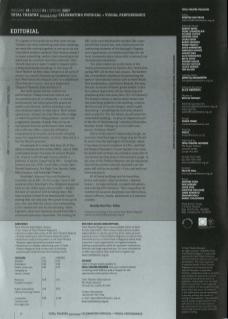It’s a given in this publication that when we say ‘theatre’ we mean something more than buildings: we mean the coming together in one space at one time which enables someone (the theatre-maker) to enact something, and for that something to be witnessed by someone else (the audience). That shared experience doesn’t need to happen within a dedicated theatre building. In this issue of Total Theatre we hear about theatre in all sorts of places: in a wood (Shimadai by Scarabeus); on a bus (Mat Fraser at Liverpool Live); in a warehouse (Punchdrunk’s Faust); and on a bandstand (Ragroof Theatre’s Shall We Dance?).
But built venues remain vital to live performance. Theatre and arts centres are an essential part of a community – a site for performance, but also a place for people to gather and interact, and for workshops and educational projects to take place. Built venues (good ones, anyway) do more than offer a stage on which to perform: they produce, curate and programme seasons of work; they act as an operational base for performance that takes place off site; offer a space for affiliated companies to be housed; and provide rehearsal space for supported artists. In short, they act as a hub for theatre practice.
An example of a venue that does all of the above is Battersea Arts Centre (BAC), who in 2006 celebrated twenty-five years of vibrant theatre life. A quick scroll through history reveals a plethora of names supported by BAC – Complicite, Lumiere and Son, DV8, David Glass, Faulty Optic, Shared Experience, The Right Size, Kazuko Hohki, Ridiculusmus, and Kneehigh Theatre.
Kneehigh’s Rapunzel has just finished a successful run at BAC. On 12 January I was in the audience when Kneehigh’s Mike Shepherd bounced back on set (after many curtain calls – despite the lack of curtains) with breaking news: BAC had received a letter from Wandsworth Council stating that not only was their grant to be cut to zero, but also that the council were demanding a full commercial rent for the building. Taken together, these two measures would make BAC’s continued operation impossible. The funding for BAC costs each Wandsworth resident 38p a year out of their council tax: not a lot to ensure the continuing existence of the borough’s flagship arts organisation, an essential provider for the local community and a venue with a national and international reputation.
This news comes hot on the heels of the recent announcement by Gardner Arts Centre that spring 2007 will be their last season. The Gardner has a formidable reputation for presenting the work of international artists such as Peter Brook, Wim Vandekeybus, and Ronnie Burkett, but they are also nurturers of home-grown talent: in this last season Spymonkey will be rehearsing and previewing their new show, Bliss (21–24 February). The Gardner closure is due to many factors but the underlying problem is the building, sited on the University of Sussex campus, which needs renovating – something the University doesn’t want to pay for. ‘For the future, we will want this remarkable building… to play an important part in the life of the University,’ said Vice-Chancellor Alasdair Smith. Perhaps as a nice little rentearner, Professor Smith?
And as if this weren’t depressing enough, we now learn that Dartington College may be forced to move from the Dartington Hall Estate, where it has been since its inception in 1961, and that the Theatre Museum in Covent Garden is to close. No doubt both of these are viewed as tasty bits of real estate wasting away in their present usage. In the case of the Theatre Museum, we are reassured that all the archive material amassed over the years will still be accessible – if you can work out how to access it.
All of these buildings are far more than bricks and mortar: they are homes – theatre homes – lovingly nurtured, crowded with ghosts, and echoing with memories. Their requisition for commercial purposes by greedy vice chancellors, council officers, trusts, and boards is a national scandal.

